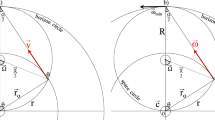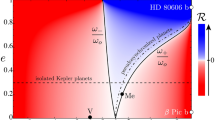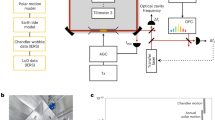Abstract
The origin of inertia has intrigued scientists and philosophers for centuries. Inertial frames of reference permeate our daily life. The inertial and centrifugal forces, such as the pull and push that we feel when our vehicle accelerates, brakes and turns, arise because of changes in velocity relative to uniformly moving inertial frames. A classical interpretation ascribed these forces to acceleration relative to some absolute frame independent of the cosmological matter, whereas an opposite view related them to acceleration relative to all the masses and ‘fixed stars’ in the Universe. An echo and partial realization of the latter idea can be found in Einstein’s general theory of relativity, which predicts that a spinning mass will ‘drag’ inertial frames along with it. Here I review the recent measurements of frame dragging using satellites orbiting Earth.
This is a preview of subscription content, access via your institution
Access options
Subscribe to this journal
Receive 51 print issues and online access
$199.00 per year
only $3.90 per issue
Buy this article
- Purchase on Springer Link
- Instant access to full article PDF
Prices may be subject to local taxes which are calculated during checkout





Similar content being viewed by others
References
Misner, C. W., Thorne, K. S. & Wheeler, J. A. Gravitation (Freeman, San Francisco, 1973)
Weinberg, S. Gravitation and Cosmology: Principles and Applications of the General Theory of Relativity (Wiley, New York, 1972)
Ciufolini, I. & Wheeler, J. A. Gravitation and Inertia (Princeton Univ. Press, Princeton, New Jersey, 1995)
Einstein, A. Letter to Ernst Mach. Zurich, 25 June 1913. In Gravitation (Misner, C. W., Thorne, K. S. & Wheeler, J. A.) 544 (Freeman, San Francisco, 1973)
Mach, E. Die Mechanik in Ihrer Entwicklung Historisch Kritisch-Dargestellt (Brockhaus, Leipzig, 1912); transl. The Science of Mechanics (Open Court, La Salle, Illinois, 1960)
Barbour, J.P. & fister, H. (eds) Mach's Principle. From Newton's Bucket to Quantum Gravity (Birkhauser, Boston, 1995)
Will, C. M. Was Einstein Right? Putting General Relativity to the Test 2nd edn (Basic Books, New York, 1993)
Will, C. M. Theory and Experiment in Gravitational Physics 2nd edn (Cambridge Univ. Press, Cambridge, UK, 1993)
Will, C. M. The confrontation between general relativity and experiment. Living Rev. Rel. 9, 3 (2006); 〈http://www.livingreviews.org/lrr-2006-3〉
Landau, L. D. & Lifshitz, E. M. The Classical Theory of Fields 3rd rev., English edn. (Pergamon, London, 1971)
Zeldovich & Novikov, I. D. Relativistic Astrophysics Vol. I Stars and Relativity (Univ. Chicago Press, Chicago, 1971)
Ciufolini, I. & Ricci, F. Time delay due to spin inside a rotating shell. Class. Quantum Grav. 19, 3875–3881 (2002)
Thorne, K. S., Price, R. H. & Macdonald, D. A. The Membrane Paradigm (Yale Univ. Press, New Haven, 1986)
Schäfer, G. Gravitomagnetic effects. J. Gen. Rel. Grav. 36, 2223–2235 (2004)
Ciufolini, I. & Pavlis, E. C. A confirmation of the general relativistic prediction of the Lense–Thirring effect. Nature 431, 958–960 (2004)
Ciufolini, I., Pavlis, E. C. & Peron, R. Determination of frame-dragging using Earth gravity models from CHAMP and GRACE. New Astron. 11, 527–550 (2006)
Ashtekar, A. Gravity, geometry and the quantum. In Proc. Albert Einstein Century Int. Conf. (Paris, 18–22 July 2005) (eds Alimi, J.-M. & Füzfa, A.) (American Institute of Physics, New York, 2006)
Penrose, R. Gravitational collapse and space–time singularities. Phys. Rev. Lett. 14, 57–59 (1965)
Hawking, S. W. & Ellis, G. F. R. The Large Structure of Space-time (Cambridge Univ. Press, Cambridge, 1973)
de Sitter, W. On Einstein's Theory of Gravitation and its astronomical consequences. Mon. Not. R. Astron. Soc. 77, 155–184 (1916)
Lense, J. & Thirring, H. Über den Einfluss der Eigenrotation der Zentralkorper auf die Bewegung der Planeten und Monde nach der Einsteinschen Gravitationstheorie. Phys. Z. 19, 156–163 (1918)
Bender, P. L. et al. The lunar laser ranging experiment. Science 182, 229–238 (1973)
Williams, J. G., Turyshev, S. G. & Murphy, T. W. Improving LLR tests of gravitational theory. Int. J. Mod. Phys. D 13, 567–582 (2004)
Cohen, S. C. & Dunn, P. J. LAGEOS scientific results. J. Geophys. Res. B 90, 9215–9438 (1985)
Noomen, R., Klosko, S., Noll, C. & Pearlman, M. (eds) Toward Millimeter Accuracy. NASA CP 2003–212248 Proc. 13th Int. Laser Ranging Workshop (NASA Goddard, Greenbelt, Maryland, 2003)
Ciufolini, I. Measurement of the Lense-Thirring drag on high-altitude laser-ranged artificial satellites. Phys. Rev. Lett. 56, 278–281 (1986)
Ciufolini, I. On a new method to measure the gravitomagnetic field using two orbiting satellites. Nuovo Cimento. A 109, 1709–1720 (1996)
Ciufolini, I. A comprehensive introduction to the LAGEOS gravitomagnetic experiment. Int. J. Mod. Phys. A 4, 3083–3145 (1989)
Ries, J. C., Eanes, R. J., Watkins, M. M. & Tapley, B. NASA-ASI Study, Report Part A (CSR, Austin, 1989)
Ciufolini, I. et al. Italian Space Agency Phase A Report on LARES. (Italian Space Agency, ASI, Rome, 1998)
Rubincam, D. P. Drag on the LAGEOS satellite. J. Geophys. Res. B 95, 4881–4886 (1990)
Lucchesi, D. M. Reassessment of the error modelling of non-gravitational perturbations on LAGEOS II and their impact in the Lense-Thirring derivation. Part II. Planet. Space Sci. 50, 1067–1100 (2002)
Kaula, W. M. Theory of Satellite Geodesy (Blaisdell, Waltham, 1966)
Reigber, C. et al. An Earth gravity field model complete to degree and order 150 from GRACE: EIGENGRACE02S. J. Geodyn. 39, 1–10 (2005)
Ciufolini, I., Pavlis, E. C., Chieppa, F., Fernandes-Vieira, E. & Perez-Mercader, J. Test of general relativity and measurement of the Lense–Thirring effect with two Earth satellites. Science 279, 2100–2103 (1998)
Ciufolini, I., Chieppa, F., Lucchesi, D. & Vespe, F. Test of Lense-Thirring orbital shift due to spin. Class. Quantum Grav. 14, 2701–2726 (1997)
Ries, J. C., Eanes, R. J., Tapley, B. D. & Peterson, G. E. Prospects for an improved Lense-Thirring test with SLR and the GRACE gravity mission. In Toward Millimeter Accuracy. Proc. 13th Int. Laser Ranging Workshop (eds Noomen, R., Klosko, S., Noll, C. & Pearlman, M.) Report NASA CP 2003–212248 (NASA Goddard, Greenbelt, Maryland, 2003)
Pavlis, E. C. in Recent Developments in General Relativity (Genoa, 2000) (eds Cianci, R. et al.) 217–233 (Springer Italia, Milan, 2002)
Reigber et al. GRACE orbit and gravity field recovery at GFZ Potsdam—first experiences and perspectives. Eos (Fall Meet. Suppl.) 83 (47), abstr. G12B–03. (2002)
Tapley, B. D. The GRACE mission: status and performance assessment. Eos (Fall Meet. Suppl.) 83 (47), abstr. G12B–01. (2002)
Ciufolini, I. et al. in Proc. First Intl School of Astrophysical Relativity “John Archibald Wheeler”: Frame-Dragging, Gravitational-Waves and Gravitational Tests (eds Ciufolini, I. & Matzner, R. A.) (Springer, in the press).
Pugh, G. E. Proposal for a Satellite Test of the Coriolis Prediction of General Relativity. Weapons Systems Evaluation Group Research Memorandum N. 11 (The Pentagon, Washington, 1959)
Schiff, L. I. Motion of a gyroscope according to Einstein's Theory of Gravitation. Proc. Natl. Acad. Sci. 46, 871–882 (1960)
Schiff, L. I. Possible new test of General Relativity Theory. Phys. Rev. Lett. 4, 215–217 (1960)
Everitt, C. W. F. et al. Papers on the Stanford Relativity gyroscope experiment (NASA Gravity Probe B). Proc. SPIE 619, 29–165 (Society for Photo-Optical Instrumentation Engineers, Washington, 1986)
Fitch, V. L. et al. Review of Gravity Probe B (National Academic Press, Washington DC, 1995)
Buchman, S., Everitt, C. W. F., Parkinson, B., Turneaure, J. P. & Keiser, G. M. Cryogenic gyroscopes for the relativity mission. Physica B 280, 497–498 (2000)
Becker, R., Heller, G. & Sauter, F. Über die Stromverteilung in Einer Supraleitenden Kugel. Z. Phys. 85, 772–787 (1933)
London, F. Superfluids Vol. 1 (Wiley, New York, 1950)
Muhlfelder, B., Keiser, G. M. & Turneaure, J. GP-B Experiment Error: A Work in Progress. (Stanford Univ., Stanford, April 2007); poster at 〈http://einstein.stanford.edu/content/aps_posters/ExperimentError.pdf〉
Gill, D. K. & Buchman, S. Evidence for Patch Effect Forces On the Gravity Probe B Gyroscopes. (Stanford Univ., Stanford, April 2007); poster at 〈http://einstein.stanford.edu/content/aps_posters/EvidenceForPatchEffectForces.pdf〉
Barker, B. M. & O’Connel, R. F. The gyroscope test of General Relativity. Nature 312, 314 (1984)
Barker, B. M. & O’Connel, R. F. The gravitational interaction: spin, rotation, and quantum effects—a review. Gen. Rel. Grav. 11, 149–175 (1979)
de Sitter, W. On Einstein's Theory of Gravitation and its Astronomical Consequences. Mon. Not. R. Astron. Soc. 76, 699–728 (1916)
Ciufolini, I. Gravitomagnetism, frame-dragging and lunar laser ranging. Preprint at 〈http://xxx.lanl.gov/abs/0704.3338〉 (10 May, 2007)
Ashby, N. & Shahid-Saless, B. Geodetic precession or dragging of inertial frames? Phys. Rev. D 42, 1118–1122 (1990)
O’Connell, R. F. A note on frame dragging. Class. Quant. Grav. 22, 3815–3816 (2005)
Williams, J. G., Turyshev, S. G. & Boggs, D. H. Progress in lunar laser ranging tests of relativistic gravity. Phys. Rev. Lett. 93, 261101 (2004)
Williams, J. G., Newhall, X. X. & Dickey, J. O. Relativity parameters determined from lunar laser ranging. Phys. Rev. D 53, 6730–6739 (1996)
Bertotti, B., Ciufolini, I. & Bender, P. L. New test of general relativity: measurement of de Sitter geodetic precession rate for lunar perigee. Phys. Rev. Lett. 58, 1062–1065 (1987)
Weisberg, J. M. & Taylor, J. H. General relativistic geodetic spin precession in binary pulsar B1913+16: mapping the emission beam in two dimensions. Astrophys. J. 576, 942–949 (2002)
Stairs, I. H., Thorsett, S. E. & Arzoumanian, Z. Measurement of gravitational spin-orbit coupling in a binary-pulsar system. Phys. Rev. Lett. 93, 141101 (2004)
Murphy, T. W., Nordtvedt, K. & Turyshev, S. G. Gravitomagnetic influence on gyroscopes and on the lunar orbit. Phys. Rev. Lett. 98, 071102 (2007)
Kopeikin, S. M. Comment on “The gravitomagnetic influence on gyroscopes and on the lunar orbit”. Phys. Rev. Lett. 98, 229001 (2007)
Kopeikin, S. M. & Fomalont, E. B. Gravimagnetism, causality, and aberration of gravity in the gravitational light-ray deflection experiments. Gen. Rel. Grav. (in the press); preprint at 〈http://xxx.lanl.gov/abs/gr-qc/0510077〉 (2005)
Will, C. M. Propagation speed of gravity and the relativistic time delay. Astrophys. J. 590, 683–690 (2003)
Cui, W. et al. Evidence for frame-dragging around spinning black holes in X-ray binaries. Astrophys. J. 492, L53–L58 (1998)
Hewish, A., Bell, S. J., Pilkington, J. D. H., Scott, P. F. & Collins, R. A. Observation of a rapidly pulsating radio source. Nature 217, 709–713 (1968)
Stairs, I. H. Testing General Relativity with pulsar timing. Living Rev. Rel. 6, 5 (2003); 〈http://relativity.livingreviews.org/articles/lrr-2003-5/index.html〉
Backer, D. C., Kulkami, S. R., Heiles, C., Davis, M. M. & Goss, W. M. A millisecond pulsar. Nature 300, 615–618 (1982)
Hulse, R. A. & Taylor, J. H. Discovery of a pulsar in a binary system. Astrophys. J. 195, L51–L53 (1975)
Kramer, M. et al. Tests of general relativity from timing the double pulsar. Science 314, 97–102 (2006)
Nordtvedt, K. Existence of the gravitomagnetic interaction. Int. J. Theor. Phys. 27, 1395–1404 (1988)
Riess, A. et al. Observational evidence from supernovae for an accelerating universe and a cosmological constant. Astron. J. 116, 1009–1038 (1998)
Perlmutter, S. et al. Measurements of Ω and Λ from 42 high-redshift supernovae. Astrophys. J. 517, 565–586 (1999)
Perlmutter, S. Supernovae, dark energy, and the accelerating universe. Phys. Today 56, 53–59 (2003)
Caldwell, R. R. Dark energy. Phys. World 17, 37–42 (2004)
Adelberger, E., Heckel, B. & Hoyle, C. D. Testing the gravitational inverse-square law. Phys. World 18, 41–45 (2005)
Amelino-Camelia, G., Ellis, J., Mavromatos, N. E., Nanopoulos, D. V. & Sarkar, S. Potential sensitivity of gamma-ray burster observations to wave dispersion in vacuo. Nature 393, 763–765 (1998)
Dvali, G. Filtering gravity: modification at large distances? In Proc. Nobel Symp. 127 on String Theory and Cosmology (Sigtuna, Sweden, 2003) (eds Danielsson, U., Goobar, A. & Nilsson, B. ) (World Scientific, Singapore, 2005); also preprint at 〈http://arXiv.org/hep-th/0402130〉 (2004)
Kerr, R. P. Gravitational field of a spinning mass as an example of algebraically special metrics. Phys. Rev. Lett. 11, 237–238 (1963)
Ciufolini, I. et al. NASA-ASI Study, Report Part B (ASI, Rome, 1989)
Acknowledgements
I gratefully acknowledge the support of the Italian Space Agency and the comments of R. Matzner of the Centre for Relativity, University of Texas at Austin, I. Novikov of the Astro Space Centre, Lebedev Physical Institute Moscow and D. P. Rubincam of NASA-Goddard.
Author information
Authors and Affiliations
Corresponding author
Ethics declarations
Competing interests
Reprints and permissions information is available at www.nature.com/reprints. The authors declare no competing financial interests.
Rights and permissions
About this article
Cite this article
Ciufolini, I. Dragging of inertial frames. Nature 449, 41–47 (2007). https://doi.org/10.1038/nature06071
Issue Date:
DOI: https://doi.org/10.1038/nature06071
This article is cited by
-
100 kHz satellite laser ranging demonstration at Matera Laser Ranging Observatory
Journal of Geodesy (2021)
-
Studies on the materials of LARES 2 satellite
Journal of Geodesy (2019)
-
Laser geodetic satellites: a high-accuracy scientific tool
Journal of Geodesy (2019)
-
The LARES 2 satellite: new challenges for design and ground test
Aerotecnica Missili & Spazio (2018)
-
Gravitomagnetic field of rotating rings
Astrophysics and Space Science (2016)
Comments
By submitting a comment you agree to abide by our Terms and Community Guidelines. If you find something abusive or that does not comply with our terms or guidelines please flag it as inappropriate.



